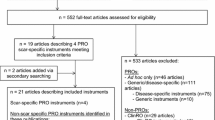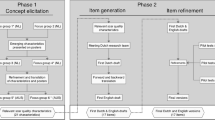Abstract
Purpose
To investigate whether the Observer Scale of the Patient and Observer Scar Assessment Scale (POSAS) can serve as a generic measure for scar quality across different scar types.
Methods
A collection of POSAS scores derived from several clinical trials on burn (n = 404), linear (n = 384), and keloidal scars (n = 282) was analyzed using the partial credit model of the Rasch analysis package RUMM2030.
Results
Differential item functioning (DIF) was observed for the Observer Scale of the POSAS between the three scar types for the items pliability, thickness, and surface area, which could be solved by item splitting. The items pigmentation and thickness showed disordered thresholds, considerable misfit, and unpredictability.
Conclusion
Users of the Observer Scale of the POSAS must be aware that the raw scores obtained from burn, linear, and keloidal scars cannot be compared without the scar-specific DIF adjustment of the items pliability, thickness, and surface area.


Similar content being viewed by others
References
Baur, K. M., Hardy, P. E., & Van Dorsten, B. (1998). Posttraumatic stress disorder in burn populations: A critical review of the literature. Journal of Burn Care and Rehabilitation, 19(3), 230–240.
Rumsey, N., Clarke, A., & White, P. (2003). Exploring the psychosocial concerns of outpatients with disfiguring conditions. Journal of Wound Care, 12(7), 247–252.
Van Loey, N. E., & Van Son, M. J. (2003). Psychopathology and psychological problems in patients with burn scars: Epidemiology and management. American Journal of Clinical Dermatology, 4(4), 245–272.
van der Wal, M. B., Verhaegen, P. D., Middelkoop, E., & van Zuijlen, P. P. (2012). A clinimetric overview of scar assessment scales. Journal of Burn Care Res, 33(2), e79–e87.
Verhaegen, P. D., van der Wal, M. B., Middelkoop, E., & van Zuijlen, P. P. (2011). Objective scar assessment tools: A clinimetric appraisal. Plastic and Reconstructive Surgery, 127(4), 1561–1570.
van Zuijlen, P. P., Angeles, A. P., Kreis, R. W., Bos, K. E., & Middelkoop, E. (2002). Scar assessment tools: Implications for current research. Plastic and Reconstructive Surgery, 109(3), 1108–1122.
Sullivan, T., Smith, J., Kermode, J., McIver, E., & Courtemanche, D. J. (1990). Rating the burn scar. Journal of Burn Care and Rehabilitation, 11(3), 256–260.
Baryza, M. J., & Baryza, G. A. (1995). The Vancouver Scar Scale: An administration tool and its interrater reliability. Journal of Burn Care and Rehabilitation, 16(5), 535–538.
Draaijers, L. J., Tempelman, F. R., Botman, Y. A., Tuinebreijer, W. E., Middelkoop, E., Kreis, R. W., et al. (2004). The Patient and Observer Scar Assessment Scale: A reliable and feasible tool for scar evaluation. Plastic and Reconstructive Surgery, 113(7), 1960–1965.
van de Kar, A. L., Corion, L. U., Smeulders, M. J., Draaijers, L. J., van der Horst, C. M., & van Zuijlen, P. P. (2005). Reliable and feasible evaluation of linear scars by the Patient and Observer Scar Assessment Scale. Plastic and Reconstructive Surgery, 116(2), 514–522.
O’Connell, D. A., Diamond, C., Seikaly, H., & Harris, J. R. (2008). Objective and subjective scar aesthetics in minimal access vs conventional access parathyroidectomy and thyroidectomy surgical procedures: A paired cohort study. Archives of Otolaryngology: Head and Neck Surgery, 134(1), 85–93.
Cromi, A., Ghezzi, F., Gottardi, A., Cherubino, M., Uccella, S., & Valdatta, L. (2010). Cosmetic outcomes of various skin closure methods following cesarean delivery: A randomized trial. American Journal of Obstetrics and Gynecology, 203(1), 36e31–36e38.
Bianchi, F. A., Roccia, F., Fiorini, P., & Berrone, S. (2010). Use of Patient and Observer Scar Assessment Scale for evaluation of facial scars treated with self-drying silicone gel. Journal of Craniofacial Surgery, 21(3), 719–723.
van der Wal, M. B., van Zuijlen, P. P., van de Ven, P., & Middelkoop, E. (2010). Topical silicone gel versus placebo in promoting the maturation of burn scars: A randomized controlled trial. Plastic and Reconstructive Surgery, 126(2), 524–531.
van der Wal, M. B., Tuinebreijer, W. E., Bloemen, M. C., Verhaegen, P. D., Middelkoop, E., & van Zuijlen, P. P. (2012). Rasch analysis of the Patient and Observer Scar Assessment Scale (POSAS) in burn scars. Quality of Life Research, 21(1), 13–23.
Peacock, E. E, Jr, Madden, J. W., & Trier, W. C. (1970). Biologic basis for the treatment of keloids and hypertrophic scars. Southern Medical Journal, 63(7), 755–760.
Niessen, F. B., Spauwen, P. H., Schalkwijk, J., & Kon, M. (1999). On the nature of hypertrophic scars and keloids: A review. Plastic and Reconstructive Surgery, 104(5), 1435–1458.
Muir, I. F. (1990). On the nature of keloid and hypertrophic scars. British Journal of Plastic Surgery, 43(1), 61–69.
Ehrlich, H. P., Desmouliere, A., Diegelmann, R. F., Cohen, I. K., Compton, C. C., Garner, W. L., et al. (1994). Morphological and immunochemical differences between keloid and hypertrophic scar. American Journal of Pathology, 145(1), 105–113.
van der Wal, M. B., Vloemans, J. F., Tuinebreijer, W. E., van de Ven, P., van Unen, E., van Zuijlen, P. P., et al. (2012). Outcome after burns: An observational study on burn scar maturation and predictors for severe scarring. Wound Repair and Regeneration, 20(5), 676–687.
Verhaegen, P. D., van Zuijlen, P. P., Pennings, N. M., van Marle, J., Niessen, F. B., van der Horst, C. M., et al. (2009). Differences in collagen architecture between keloid, hypertrophic scar, normotrophic scar, and normal skin: An objective histopathological analysis. Wound Repair and Regeneration, 17(5), 649–656.
Verhaegen, P. D., van der Wal, M. B., Bloemen, M. C., Dokter, J., Melis, P., Middelkoop, E., et al. (2011). Sustainable effect of skin stretching for burn scar excision: Long-term results of a multicenter randomized controlled trial. Burns, 37(7), 1222–1228.
Bloemen, M. C., van Gerven, M. S., van der Wal, M. B., Verhaegen, P. D., & Middelkoop, E. (2011). An objective device for measuring surface roughness of skin and scars. Journal of the American Academy of Dermatology, 64(4), 706–715.
van der Wal, M. B., Bloemen, M. C., Verhaegen, P. D., Tuinebreijer, W. E., de Vet, H. C., van Zuijlen, P. P., et al. (2013). Objective color measurements: clinimetric performance of three devices on normal skin and scar tissue J Burn Care Res, 34(3), 187–194.
Bloemen, M. C., van der Wal, M. B., Verhaegen, P. D., Nieuwenhuis, M. K., van Baar, M. E., van Zuijlen, P. P., et al. (2012). Clinical effectiveness of dermal substitution in burns by topical negative pressure: A multicenter randomized controlled trial. Wound Repair and Regeneration, 20(6), 797–805.
Linacre, J. M. (1994). Sample size and item calibration stability. Rasch Measurement Transactions, 7(4), 328.
Linacre, J. M. (2002). Optimizing rating scale category effectiveness. Journal of Applied Measurement, 3(1), 85–106.
Tennant, A., & Conaghan, P. G. (2007). The Rasch measurement model in rheumatology: What is it and why use it? When should it be applied, and what should one look for in a Rasch paper? Arthritis and Rheumatism, 57(8), 1358–1362.
Fisher, W. P, Jr. (1992). Reliability statistics. Rasch Measurement Transactions, 6, 238.
Wright, B. D., & Masters, G. (2002). Number of person or item strata. Rasch Measurement Transactions, 16, 888.
Nunnaly, J. C. (1978). Psychometric Theory (2nd (edition ed.). New York: McGraw-Hill.
Bland, J. M., & Altman, D. G. (1995). Multiple significance tests: The Bonferroni method. BMJ, 310(6973), 170.
Smith, E. V, Jr. (2002). Detecting and evaluating the impact of multidimensionality using item fit statistics and principal component analysis of residuals. Journal of Applied Measurement, 3(2), 205–231.
Tennant, A., & Pallant, J. F. (2012). The root mean square error of approximation (RMSEA) as a supplementary statistic to determine fit to the Rasch model with large sample sizes. Rasch Measurement Transactions, 4, 1348–1349.
Wright, B. D. (1996). Local dependency, correlations and principal components. Rasch Measurement Transactions, 10, 509–511.
Wainer, H., & Kiely, G. (1987). Item clusters and computer adaptive testing: A case for testlets. Journal of Educational Measurement, 24(3), 185–201.
Andrich, D., & Hagquist, C. (2011). Real and artificial differential item functioning. Journal of Educational and Behavioral Statistics, 37, 387–416.
Bond, T. G., & Fox, C. M. (2007). Model Fit and Unidimensionality. In Applying the Rasch model. Fundamental measurement in the human sciences. Second Edition, (pp. 236–260).
Lundgren-Nilsson, A., Grimby, G., Ring, H., Tesio, L., Lawton, G., Slade, A., et al. (2005). Cross-cultural validity of functional independence measure items in stroke: A study using Rasch analysis. Journal of Rehabilitation Medicine, 37(1), 23–31.
Cunningham, T. J., Berkman, L. F., Gortmaker, S. L., Kiefe, C. I., Jacobs, D. R, Jr, Seeman, T. E., et al. (2011). Assessment of differential item functioning in the experiences of discrimination index: The coronary artery risk development in young adults (CARDIA) Study. American Journal of Epidemiology, 174(11), 1266–1274.
Lawton, G., Bhakta, B. B., Chamberlain, M. A., & Tennant, A. (2004). The Behcet’s disease activity index. Rheumatology (Oxford), 43(1), 73–78.
Gothwal, V. K., Wright, T. A., Lamoureux, E. L., & Pesudovs, K. (2009). Rasch analysis of visual function and quality of life questionnaires. Optometry and Vision Science, 86(10), 1160–1168.
Gothwal, V. K., Wright, T., Lamoureux, E. L., & Pesudovs, K. (2010). Psychometric properties of visual functioning index using Rasch analysis. Acta Ophthalmologica, 88(7), 797–803.
Weisscher, N., Glas, C. A., Vermeulen, M., & De Haan, R. J. (2010). The use of an item response theory-based disability item bank across diseases: Accounting for differential item functioning. Journal of Clinical Epidemiology, 63(5), 543–549.
van Groen, M. M., ten Klooster, P. M., Taal, E., van de Laar, M. A., & Glas, C. A. (2010). Application of the health assessment questionnaire disability index to various rheumatic diseases. Quality of Life Research, 19(9), 1255–1263.
Acknowledgments
The authors would like to thank L.C. Langenberg and D. Wellenstein for their assistance in collecting the data.
Author information
Authors and Affiliations
Corresponding author
Rights and permissions
About this article
Cite this article
van der Wal, M.B.A., Tuinebreijer, W.E., Lundgren-Nilsson, Å. et al. Differential item functioning in the Observer Scale of the POSAS for different scar types. Qual Life Res 23, 2037–2045 (2014). https://doi.org/10.1007/s11136-014-0637-4
Accepted:
Published:
Issue Date:
DOI: https://doi.org/10.1007/s11136-014-0637-4




